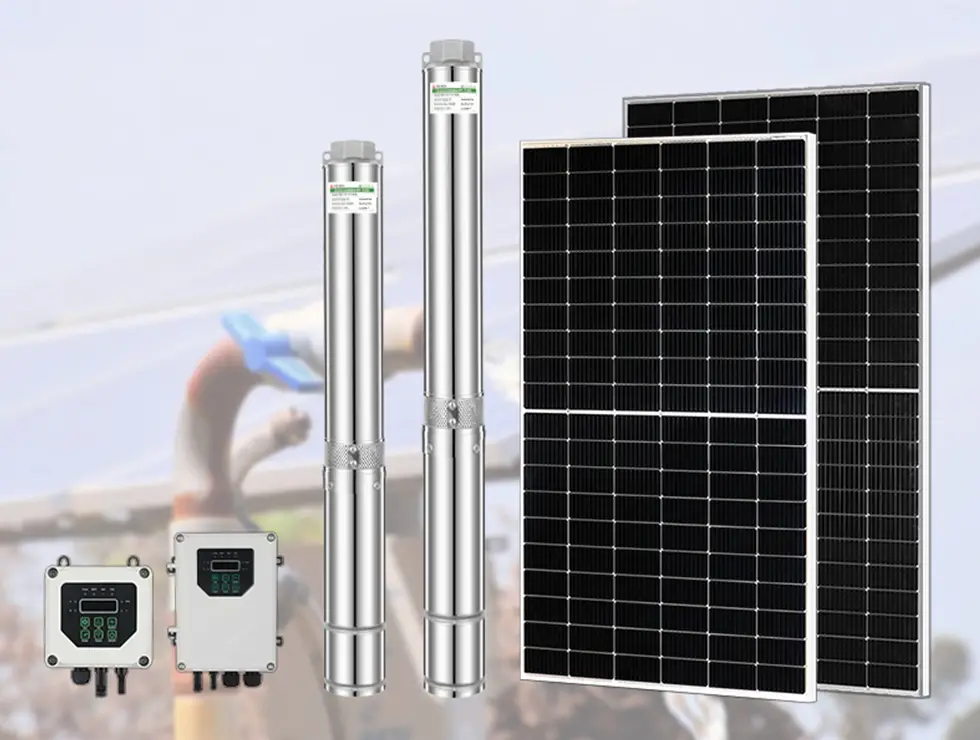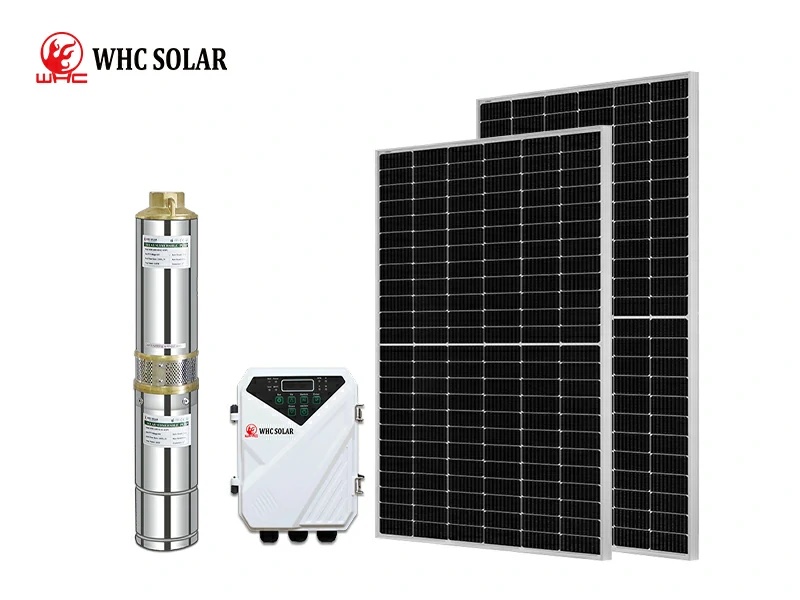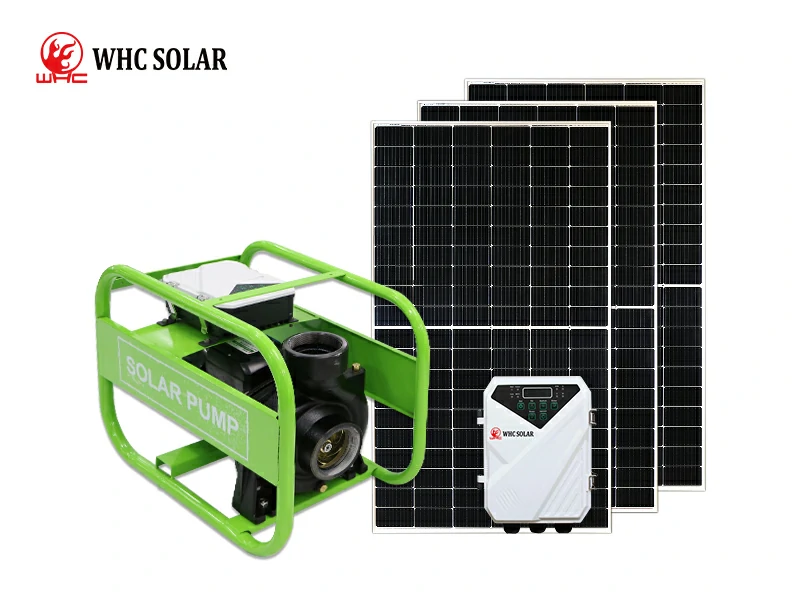In a world where sustainable solutions are becoming increasingly vital, harnessing the power of the sun emerges as a beacon of innovation. In this comprehensive guide, we delve into the realm of solar water pumps—a technology that not only taps into the Earth’s most abundant energy source but also promises a greener and more efficient approach to water management.
Imagine a system where the sun’s rays not only illuminate our days but also drive the pumps that bring water to fields, homes, and communities. Join us on a journey as we explore the workings, benefits, and transformative potential of solar water pumps, paving the way for a more sustainable and resilient future.
Solar Water Pump:
A solar water pump is like a smart helper that uses sunlight to move water from one place to another. Unlike regular pumps that need electricity, these pumps use energy from the sun, making them eco-friendly and easy on our wallets. In simple terms, a solar water pump is a green technology that brings water to where we need it, using the sun’s energy to do the job. Let’s dive into this amazing technology and see how it works its magic.

Working of Solar Water Pump:
The working of the solar water pump is explained below:
1. Solar Panels:
The process begins with solar panels, which are typically installed on the ground or on rooftops. These panels are made up of photovoltaic (PV) cells that convert sunlight into electricity. When sunlight hits the solar panels, it creates an electric current within the cells.
2. Powering the Pump:
The electricity generated by the solar panels is then sent to a controller. The controller regulates the amount of power and ensures that it matches the requirements of the water pump. This step is crucial to protect the pump from fluctuations in power and to optimize its efficiency.
3. DC Pumps:
DC water pumps are more common in solar water pump systems as they are well-suited for the variable power output of solar panels. AC pumps may require an additional inverter to convert the DC power generated by the solar panels into AC power.
4. Solar Submersible water pump or Solar Surface Water Pumps:
The pump, which can be submersible or surface-mounted, is responsible for moving water from one place to another. Solar Submersible pumps are placed underwater, usually in a well or
borehole, while Solar Surface Water Pumps are situated above ground and draw water from a source like a pond or a reservoir.
5. Water Delivery:
Once the pump is activated, it starts lifting or pushing water from the source (such as a well or a reservoir) to the destination, which could be an irrigation system, a storage tank, or directly to fields or homes. The pump continues to operate as long as sunlight is available, making it a sustainable and renewable source of power.
6. Optional Storage:
In some setups, a storage system like a tank or reservoir may be incorporated to store water for later use, ensuring a continuous water supply even during periods of low sunlight.
The beauty of solar water pump systems lies in their simplicity and efficiency. They harness the sun’s energy to power a pump, eliminating the need for external electricity sources and reducing both costs and environmental impact.

Types of Solar Water Pumps:
Like tools in a diverse toolbox, solar water pumps come in various types, each designed to suit specific needs and conditions. Understanding the different types of solar water pumps is crucial for choosing the right solution based on factors such as water requirements, geographical location, and intended applications.
From submersible to surface pumps, each type has its unique features and advantages.
- Solar Submersible water Pump (built-in model):
A solar submersible pump, also known as a built-in model, is a specialized type of solar water pump designed for submerged installations in wells, boreholes, or other water sources. This innovative pump is fully submerged underwater, providing efficient water extraction without the need for priming.
The key component of the solar submersible water pump is a water-tight electric motor, sealed to prevent water from entering. This motor is connected directly to the pump, eliminating the need for additional power transmission components.
The pump’s solar panels, usually mounted on the surface or nearby, capture sunlight and convert it into electricity. This generated electricity powers the submersible pump, which then draws water from the source and pushes it to the surface for various applications, such as irrigation or supplying water to homes and livestock.
- Solar Submersible water Pump:
A solar submersible water pump is a specialized water pumping system designed to operate while submerged in a water source, such as a well or borehole. This type of pump is particularly efficient for extracting water from deep sources, making it a practical choice for agricultural irrigation, livestock watering, and domestic water supply in areas where water tables are deep.
One of the notable advantages of solar submersible pumps is their ability to operate independently of the electric grid. This makes them especially valuable in remote or off-grid locations where access to traditional power sources may be limited.
- Solar Surface Water Pump:
A surface pump, also referred to as a surface-mounted pump, is a water pumping system designed to operate above ground level, drawing water from surface sources such as ponds, lakes, rivers, or reservoirs.
Unlike submersible pumps, which are submerged underwater in wells or boreholes, surface pumps are installed in a location that remains exposed to the air. This placement facilitates easy accessibility for maintenance and installation.
Surface pumps find diverse applications, with common uses including agricultural irrigation, domestic water supply, and livestock watering. They come in various types, including centrifugal pumps and jet pumps. Centrifugal pumps utilize a rotating impeller to create a flow of water, while jet pumps rely on suction and pressure mechanisms.
Components of Solar Water Pump:
A solar water pump consists of some important parts that are listed hereunder:
- Solar Panels
- Pump
- Controller (Inverter)
1. Solar Panels:
Solar panels are an important part of any solar water pump system. They are made up of photovoltaic (PV) cells that convert sunlight into electricity. Half-cut solar panels, a popular and efficient design, feature solar cells that are split into two halves connected in series. This design reduces electrical resistance, increases efficiency, and enhances the panel’s performance in varying light conditions. These panels are typically made of crystalline silicon.
2. Pump:
The pump is responsible for moving water from the source to the desired location. There are two main types of solar water pumps: submersible and surface pumps. Submersible pumps are placed underwater, often in a well or borehole, while surface pumps are located above ground and draw water from a source like a pond or reservoir. The choice between the two depends on factors such as the water source, depth, and the specific requirements of the application.
3. Controller (Inverter):
The controller, sometimes referred to as an inverter, plays a crucial role in regulating and optimizing the power flow between the solar panels and the water pump. It ensures that the electricity generated by the solar panels is of the right type and voltage to power the pump efficiently.
The controller also protects the pump from voltage fluctuations and ensures a smooth operation. In the context of solar water pumps, the term “controller” is often used more broadly to encompass various control and monitoring devices that manage the entire system, ensuring its reliability and longevity.

How to choose a solar water pump?
Choosing the right solar water pump system involves considering several factors related to the pump’s specifications and power requirements. Here’s a breakdown of how to choose solar pumps concerning horsepower, power, maximum head, caliber, and power supply type:
1. Horsepower (HP):
Determine the horsepower of the solar water pump you plan to use. The horsepower rating indicates the power of the pump and is a critical factor in sizing the solar panel system. Higher horsepower pumps will require more solar power to operate effectively.
2. Power Requirements:
Check the power requirements of the solar water pump, usually specified in kilowatts (kW) or watts (W). This information helps in calculating the solar panel capacity needed to meet the pump’s energy demands. Ensure that the solar panels can generate sufficient power to drive the pump effectively.
3. Maximum Head:
The maximum head refers to the pump’s vertical distance to lift water from the source to the destination. It is usually measured in meters or feet. Consider the maximum head of your pump when selecting solar panels. Higher heads may require more power, affecting the sizing of the solar panel system.
4. Caliber (Diameter of the Pump):
The caliber or diameter of the pump is an important factor that influences the flow rate of water. Larger caliber pumps generally require more power. Consider the caliber of the pump to ensure the solar panel system can provide the necessary energy to meet the pump’s flow rate requirements.
5. Power Supply Type:
Determine the power supply type that your solar water pump system supports. Some pumps are designed for direct current (DC), while others may require an inverter to convert DC to alternating current (AC). Ensure that the solar panels and associated components are compatible with the power supply type of the pump.
Applications of solar water pump:
1. Deep Well Pumping Water:
Solar panels find application in deep well water pumping systems, where conventional electricity sources may be unavailable or costly to install. The panels generate electricity to power submersible pumps that draw water from deep wells, providing a sustainable and off-grid solution for accessing groundwater.
2. Agricultural Irrigation:
Solar panels play a crucial role in agricultural irrigation by powering water pumps that distribute water to crops. This sustainable approach helps farmers in remote or off-grid areas to irrigate their fields efficiently, contributing to increased agricultural productivity without relying on traditional electricity sources.
3. Vegetable Greenhouse:
Solar panels are used in vegetable greenhouses to support irrigation systems, maintaining optimal moisture levels for plant growth. The panels power water pumps that deliver water to the greenhouse, ensuring a controlled and sustainable environment for cultivating vegetables.
4. Drinking Water:
In areas where access to clean drinking water is a challenge, solar panels can be employed to power water pumps for extracting and delivering potable water. This application is particularly valuable in rural or remote regions, providing a renewable energy solution for water supply.
5. Water Tank Storage:
Solar panels contribute to water tank storage systems by powering pumps that fill and maintain water tanks. This stored water can be used for various purposes, including irrigation, domestic water supply, or emergency backup. Solar energy ensures a continuous and sustainable water supply without reliance on external power sources.

